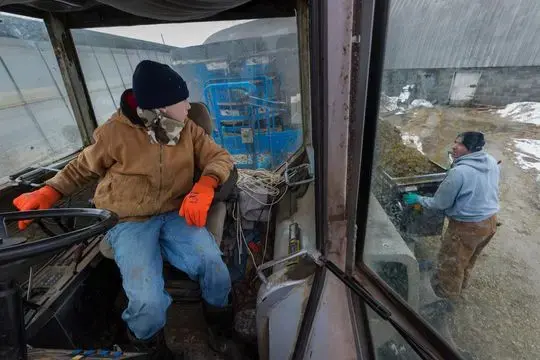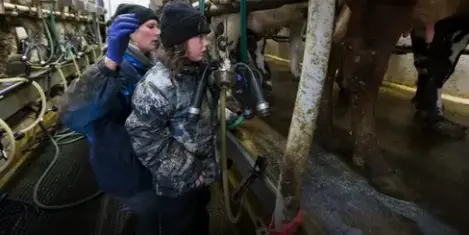Fed up with a distressing downturn in milk prices that has decimated Wisconsin dairy farms, Kendra Thewis is urging farmers to fight back to preserve their livelihood and a treasured way of life before it's too late.
Farmers, she says, ought to be "causing an uproar" instead of feeling sorry for themselves and quietly accepting whatever milk price they can get.

“We put our blood, sweat and tears into our product, only to be given a price that isn’t enough to pay ourselves or even feed the cows at times," she said. "We need to be heard now because time is running out."
She and dairy farmer Tom Crosby of Shell Lake endorse a proposal from the National Farmers Organization, based in Ames, Iowa, that would establish a two-tier milk pricing system aimed at boosting revenue for small and midsize farms.
Under the plan, which would require federal government approval, farmers would get an extra $4 for every hundred pounds (roughly 12 gallons) of milk they produce a month, up to 1 million pounds. Anything over that amount would fetch a lower price.
Backers of the plan say it is well-suited for farms milking under 300 cows, which is the majority of Wisconsin dairy farms. They say it could help keep those farms afloat during downturns such as the current one, which has lasted more than four years and claimed thousands of small and midsize dairy operations.
They say the plan wouldn’t increase costs for consumers, and that it would help level the playing field between large and small farms through a redistribution of money collected in the federal milk marketing system.
“I think it’s just imperative that we stop the bleeding. We need to do something to give farmers hope," said Crosby, a National Farmers Organization board member.
Minimum farm milk prices are set by the U.S. Department of Agriculture using complicated formulas based on the wholesale market value of various dairy products such as butter and cheese. Most farmers don't even know what they'll be paid for their milk until 30 days after it's hauled off the farm.
Since late 2014, farmers have been mired in a price slump fueled by overproduction, failing export markets and lackluster consumer demand.
Farmers say they've been getting around $15 for every hundred pounds of milk they produce while their actual cost is closer to $20. Small and midsize farms have been especially hard-hit.
“We must do more than stand by and wring our hands as independent, family-sized dairy farms disappear at such a staggering rate. ... Time is not on our side. Getting a new policy in place requires urgent action among dairy farmers across the country,” the National Farmers Organization says in a statement on its website.

Not all dairy farmers support the proposal, including some who fear it would add to the glut of milk in the marketplace by encouraging overproduction on small and medium-size farms. Also, it could be seen as unfair to large dairy operations that produce well over 1 million pounds of milk a month.
"It's very much a matter of your perspective," said Mark Stephenson, director of dairy policy analysis at University of Wisconsin-Madison and chairman of Dairy Task Force 2.0, a committee of Wisconsin dairy farmers and others that aims to chart a course for the dairy industry's future.
The two-tier proposal goes against the need for simplified pricing and a free market system, said John Holevoet, director of government affairs for the Green Bay-based Dairy Business Association.
What's more, milk is a globally traded commodity. So while U.S. farmers could benefit from higher prices, it could harm their competitiveness in international markets.
"We are subject to the pressures of a global market," said Shelly Mayer, a dairy farmer from Slinger and a Dairy Task Force 2.0 member.
The task force voted 14-7 earlier this month to not endorse a two-tier pricing system. Five members of the 31-member panel abstained.
"We came to the conclusion it needs to be researched more," Mayer said.
Looking at long-term solutions
The task force has spent months brainstorming ideas and it voted to endorse 49 of them that will be forwarded to industry, state and federal officials.
One of the recommendations calls for putting dairy-product vending machines in every school in Wisconsin, including universities. "We recommend that multiple flavors of milk be offered," the task force noted.
It urged the creation of a cheese export program, through the University of Wisconsin-Madison's Center for Dairy Research, to help cheesemakers develop products for international markets.
Currently, the U.S. exports only about 5 percent of its cheese. Foreign markets are "a huge, virtually untapped growth opportunity," according to the task force report.
The task force also endorsed recommendations including finding new markets for dairy products, studying the economic impact of agriculture on communities, the need for better rural internet service and helping small farms connect with urban consumers through agritourism.
While the group has focused on long-term solutions, it hasn't come to terms with the milk pricing issue, said member Darin Von Ruden, a third-generation dairy farmer from Westby and president of the Wisconsin Farmers Union trade group.
"We haven't done anything to change the system we're currently in," he said.
A new report from the Wisconsin Policy Forum underscores the severity of the dairy crisis, showing that Wisconsin farmers lost about half of their net income between 2011 and 2018 — forcing an increasing number of them into bankruptcy.
“In recent years a combination of increased (milk) supply and sluggish demand has created a vicious cycle where small farmers who cannot keep up are squeezed out of the market,” Wisconsin Policy Forum said in the report issued last week.
“Milk prices have dropped for various reasons, but most importantly because of increased production and reduced demand for dairy products," the report noted. "Dairy farms are becoming more efficient, mainly by increasing the amount of milk each cow produces. Additionally, the industry is consolidating into fewer, larger farms that may better handle price shocks."
Dairy processors benefit from low milk prices because it keeps their costs down. “In the long run, however, these manufacturers depend on viable dairy farms," the report said.
One in nine jobs in Wisconsin is tied to the state’s $88 billion agriculture industry and dairy represents more than half of the industry’s revenue. Hundreds of towns across the state depend on the money that dairy farmers spend at equipment dealerships, feed mills, hardware stores, cafes and scores of other businesses.
Weeks into his new job as secretary of the state Department of Agriculture, Trade and Consumer Protection, Brad Pfaff told the Milwaukee Journal Sentinel he is studying the Dairy Task Force 2.0 recommendations and seeking new markets for dairy products.
“I will say the milk price we have right now is causing real consternation for farms of all sizes," he said. "I recognize that and the governor recognizes it.”

Through the generations
At the heart of things is life on a dairy farm, where a family's home and business are intertwined and have been through the generations.
At age 3, Thewis helped her mom clean up the milking parlor. She learned to polka in the feed room with her dad. And she got married in a cornfield across the road from her parents’ place.
“I even went into labor with my daughter while milking cows," she said.
"I only hope that my kids will at least have the chance to create some of these memories."
At the rate Wisconsin is losing dairy farms, roughly two a day, that hope may be fading. As of March 1, there were 7,983 milk cow herds left in the state, down 40 percent from 10 years ago.
It angers Thewis, who stresses the urgency of the situation.
"We have to do something. We have to band together as one with a plan," she says.
How do farm families make ends meet in this difficult environment?
Often, at least one family member works an off-farm job to put groceries on the table or pay for health insurance. Some work double shifts, farming during the day then heading to a local factory for the night.
"But how can we expect to work another job while trying to maintain the quality and care needed to keep the farm running at top-notch capacity? Dairy farming is a business and a real job," said Thewis, whose farm is near Mellen in rural Ashland County.

"It is unreal to me that throughout the years, everything has been influenced by inflation and cost-of-living increases except the price that dairy farmers receive for their milk. We are still receiving prices from 20 or 30 years ago and our expenses have skyrocketed," she said.
Some experts say that perennial low milk prices could become the new normal and that small farms are especially vulnerable should that happen.
"Like all dairy farms, the family-sized operation must sell into a market plagued by low and unstable prices. But unlike its much larger counterparts, operating costs for smaller dairies are higher. Squeezed by low prices on one side, and higher operating costs on the other, it's little wonder that so many of our family-sized dairies are failing," the National Farmers Organization says.
Further, the dairy industry has “turned off a whole generation” of consumers with products such as skim milk, said David Kohl, an agricultural economist from Virginia who addressed the recent Professional Dairy Producers of Wisconsin annual conference in Madison.
“They don’t want milk that tastes like chalk," Kohl said. "Until we get aligned with what consumers are looking for and we get some of the international markets back, this milk price is going to stay down."
Recent trends in milk consumption confirm Kohl's assertion. From 2012 to 2016, skim milk sales fell 36 percent. Sales of organic milk were mostly flat, according to 2017 data, while whole milk was up 2.4 percent and flavored whole milk, such as chocolate and strawberry, was up more than 9 percent.
Kohl has counseled farmers on their business plans in these turbulent times. He’s advised some to quit farming, do a life skills assessment and move on to something else before they lose everything.
“The thing is, you don’t want to dig the hole any deeper," he said.
Nobody wants to be the one to lose a multigeneration farm, but Kohl says the economic forces working against some farms are simply too much, and that it's not the farmer's fault.
“It’s different from when mom and dad farmed," he said.




































